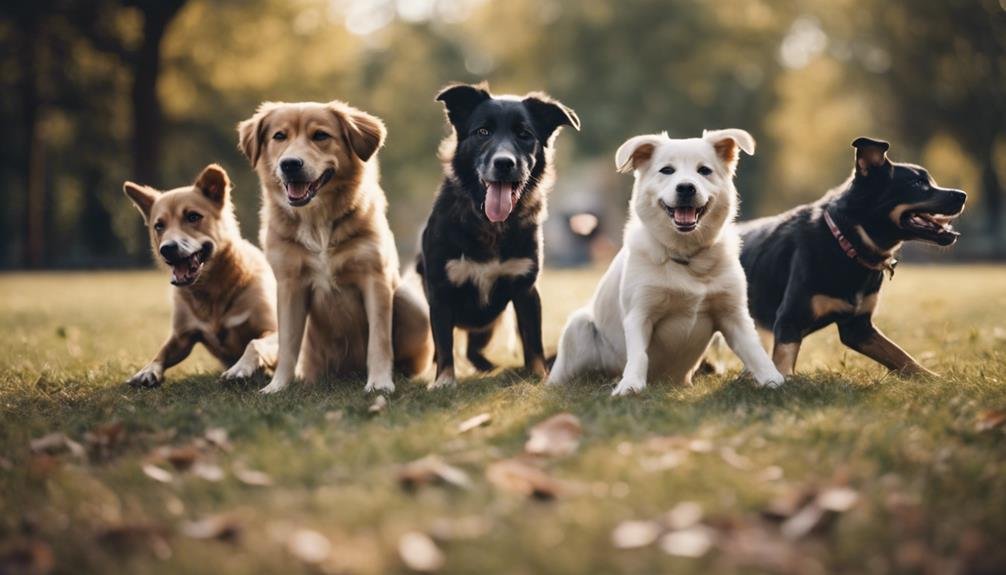The behavioral parallels between adolescent dogs and teenage humans offer a fascinating glimpse into the intricate world of animal development. As studies suggest, the similarities in cognitive and emotional shifts during this pivotal stage raise intriguing questions about the underlying mechanisms at play.
By exploring these shared characteristics, researchers aim to uncover deeper insights into the complexities of canine adolescence and its implications for training and socialization practices. Understanding how dogs navigate this critical phase not only enriches our comprehension of their behavior but also hints at the profound connections that exist between humans and their loyal canine companions.
Key Takeaways
- Adolescent dogs show behaviors mirroring teenage humans.
- Both species go through a 'rebellious' phase during adolescence.
- Brain development similarities exist between dogs and teenagers.
- Increased independence and autonomy-seeking are common in adolescent dogs.
Similar Behaviors Between Dogs and Teens
The study findings on adolescent dog behavior suggest striking parallels between the behaviors exhibited by adolescent dogs and teenage humans, highlighting intriguing similarities in their developmental stages. Both adolescent dogs and teenagers show signs of increased independence, seeking autonomy from their caregivers. This phase is marked by heightened emotions, mood swings, and a tendency towards risk-taking behaviors in both species.
Brain development in adolescent dogs mirrors that of teenage humans, affecting decision-making processes and contributing to challenges in obedience. Hormonal changes play a crucial role in shaping behavior during this critical phase. By understanding these similarities, dog owners and caregivers can better navigate the challenges of raising and training adolescent dogs, leading to the development of emotionally stable adult companions.
Behavioral Changes During Adolescence
With what behavioral changes do adolescent dogs typically grapple during their developmental phase?
- Increased Independence:
Adolescent dogs start asserting their independence by challenging authority figures and testing boundaries.
- Mood Swings and Heightened Emotions:
Similar to teenage humans, adolescent dogs may exhibit mood swings, heightened emotions, and unpredictable behavior.
- Seeking Autonomy:
During adolescence, dogs seek more autonomy and may display more disobedience as they try to establish their own identity and push boundaries.
Brain Development in Adolescent Dogs

Adolescent dogs undergo significant changes in brain development as they navigate the challenges of their developmental phase. Research indicates that during adolescence, dogs exhibit increased independence, which is accompanied by brain changes mirroring those seen in teenage humans.
This period is marked by heightened emotions, risk-taking behavior, and mood swings, all of which are influenced by hormonal shifts impacting decision-making processes. The regions of the brain responsible for processing social cues, learning, and emotional regulation are particularly active during this phase.
Understanding the intricacies of brain development in adolescent dogs is vital for comprehending their behaviors and providing appropriate guidance and training to ensure their successful transition into emotionally stable adult dogs.
Social Interaction Patterns in Dogs
Understanding the dynamics of social interaction patterns in dogs is essential for comprehending their behavior and fostering positive relationships with both other dogs and humans. Dogs exhibit a wide range of social behaviors that impact their interactions with peers and humans.
Here are three key aspects to consider:
- Communication Signals: Dogs communicate through body language, vocalizations, and facial expressions. Understanding these signals can help interpret their intentions and emotions accurately.
- Hierarchy Establishment: Dogs often establish hierarchies within their social groups, which can influence their interactions. Recognizing and respecting these hierarchies can prevent conflicts and promote harmonious relationships.
- Play Behavior: Play is a crucial aspect of social interaction in dogs. It helps them develop social skills, build relationships, and release excess energy. Monitoring and encouraging healthy play behavior is vital for their social development.
Training Adolescent Dogs Effectively

Training adolescent dogs effectively requires a consistent and positive approach to shape their behavior and foster obedience. During this crucial developmental stage, it is important to avoid punishment, as it can exacerbate unwanted behaviors.
Instead, focus on encouraging obedience through clear commands and rewarding good behavior. Enrichment activities, such as puzzle toys and interactive games, can help keep adolescent dogs mentally stimulated and engaged.
Consistent training routines, preferably using positive reinforcement methods, are essential for guiding adolescent dogs through this challenging phase. Seeking guidance from experienced trainers can provide valuable insights and strategies to address specific behavior issues.
Patience, understanding, and a structured training regimen are key components in effectively training adolescent dogs.
Guidance for Handling Adolescent Dogs
Effective guidance for handling adolescent dogs involves establishing clear boundaries and providing consistent training routines. To help navigate this important phase in a dog's development, consider the following tips:
- Encourage 'say please' behavior: Teach your adolescent dog to offer a polite behavior, like sitting, before receiving food or attention.
- Offer various enrichment activities: Engage your dog's mind and body with activities such as puzzle toys, scent work, or agility training.
- Teach impulse control: Help your dog learn to wait patiently at doors or before receiving a toy, promoting self-control and preventing impulsive behaviors.
Importance of Understanding Dog Behavior

Studying and comprehending dog behavior is essential for fostering a harmonious relationship between pets and their owners. Understanding the intricacies of dog behavior can lead to improved communication, better training outcomes, and overall well-being for both dogs and their human companions. Below is a table highlighting the key aspects of dog behavior that owners should consider:
| Aspects of Dog Behavior | Importance |
|---|---|
| Body Language | Dogs communicate through various gestures and postures. Understanding these cues helps in interpreting their emotions and needs. |
| Socialization | Proper socialization is vital for a well-adjusted adult dog. Exposing them to different environments and interactions positively shapes their behavior. |
| Training Techniques | Using positive reinforcement methods and consistency in training can effectively modify behavior and ensure obedience. |
| Exercise and Stimulation | Regular physical exercise and mental stimulation are essential for a dog's overall health and to prevent behavioral issues. |
| Behavioral Changes | Recognizing and addressing behavioral changes promptly can prevent escalation and foster a positive relationship. |
Conclusion
In conclusion, the parallels between adolescent dogs and teenage humans highlight the complex behavioral shifts and cognitive developments that occur during this developmental stage. Understanding these similarities provides valuable insights into the social interactions, brain maturation, and training efficacy of adolescent dogs.
By exploring these shared behavioral patterns, we can enhance our understanding of canine adolescence, leading to healthier relationships and improved well-being for both dogs and their human companions.




